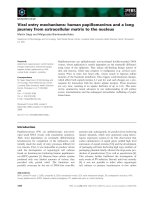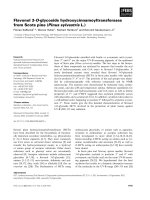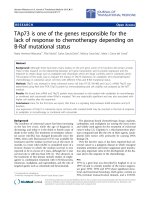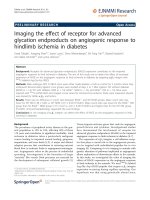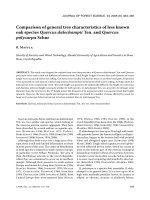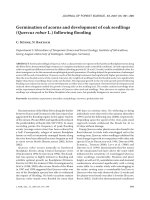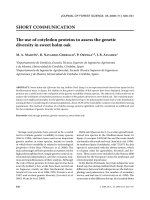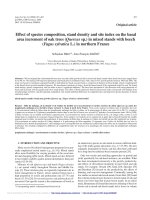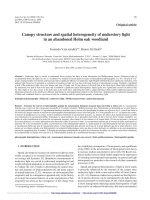Báo cáo lâm nghiệp: "Holm oak (Quercus rotundifolia Lam.) and Aleppo pine (Pinus halepensis Mill.) response to different soil preparation techniques applied to forestation in abandoned farmland" pps
Bạn đang xem bản rút gọn của tài liệu. Xem và tải ngay bản đầy đủ của tài liệu tại đây (549.01 KB, 8 trang )
171
Ann. For. Sci. 61 (2004) 171–178
© INRA, EDP Sciences, 2004
DOI: 10.1051/forest:2004009
Original article
Holm oak (Quercus rotundifolia Lam.) and Aleppo pine
(Pinus halepensis Mill.) response to different soil preparation
techniques applied to forestation in abandoned farmland
Inmaculada BOCIO*, Francisco Bruno NAVARRO, María Angeles RIPOLL, María Noelia JIMÉNEZ,
Estanislao De SIMÓN
Departamento Forestal, Centro de Investigación y Formación Agraria de Granada,
C/ Camino de Purchil s/n, Apartado de Correos 2027, 18080 Granada, Spain
(Received 16 July 2002; accepted 2 January 2003)
Abstract – This paper evaluates the effectiveness of several soil preparation procedures in forestation establishment and development in
localized farmland, within a territory in ombroclimatic transition between dry and semi-arid, located in Granada, southeastern Spain. An
experiment in the forestation of Holm oak (Quercus rotundifolia Lam.) and Aleppo pine (Pinus halepensis Mill.) was set up, in which 8 different
soil preparation techniques were used. The survival, total height and basal diameter of the plantation was monitored over a 5-year period (1996–
2000). The statistical analysis of these parameters evidenced highly significant differences in the overall behaviour of the two sample forest
species, related to changes in the prevailing environmental conditions in these territories and the type of soil preparation procedure applied. The
overall results obtained for the three parameters analysed show the effectiveness of using backhoes for pit planting and linear rippering with a
hydraulic structure to captures runoffs, in comparison to other preparations. Areal soil preparations, in particular, are not recommended.
forestation / semi-arid / soil preparation
Résumé – Réponse du chêne vert (Quercus rotundifolia Lam.) et du pin d’Alep (Pinus halepensis Mill.) à différentes techniques de
préparation du sol pour le reboisement de terrains agricoles abandonnés. Dans ce travail on évalue l’efficacité de différents procédés de
préparation du sol pour l’établissement et le développement d’un reboisement de terrains anciennement cultivés et situés dans un domaine
ombrothermique intermédiaire entre le sec et le semi-aride, à Grenade, dans le sud-est de l’Espagne. Dans ce but, on a mis en place un
reboisement expérimental de chêne vert (Quercus rotundifolia Lam.) et de pin d’Alep (Pinus halepensis Mill.) effectué selon 8 procédés
différents de préparation du sol, et pour lesquels on a relevé la survie, la hauteur totale et le diamètre basal pendant une période de 5 ans (1996–
2000). Les analyses statistiques ont mis en relief des différences significatives du comportement général des deux essences forestières testées
et en relation avec les changements des conditions de milieu et des techniques de préparation du sol. Les résultats obtenus pour les trois
paramètres analysés montrent l’efficacité des trous effectués à la pelle rétroexcavatrice et des sous-solages en ligne asssociés à une structure
hydraulique qui récolte les écoulements, par rapport à d’autres types de préparation, notamment le travail du sol en plein dont l’utilisation est
déconseillée.
reboisement / semi-aride / préparation du sol
1. INTRODUCTION
For decades the attempt to make farming profitable through
extensive farming meant that a large amount of forest was
brought under cultivation. Low crop productivity determined
a large-scale abandonment of these lands that, unprotected by
a vegetation covering and subjected to inclement Mediterra-
nean weather, rapidly suffered serious erosion and desertifica-
tion, highlighting one of the major environmental problems in
the Mediterranean Basin today [14]. Faced with this environ-
mental problem, the EU’s Common Agricultural Policy
adopted a series of environmental measures based on the imple-
mentation of programs that offered grants for investing in for-
ests on farms. These programs aimed to promote forestation in
order to restore natural vegetation in marginal farmland. They
meant that thousands of hectares of farmland were able to
recover their original forest nature through forestation.
Mediterranean ecosystems are especially resistant to intense
human disturbance [5] and to climatic and socio-economic
changes. However, if the degradation passes certain ecological
limits, especially in arid and semiarid environments, only
human intervention can reverse it, through restoration [1, 9].
In this sense, the abandoned farmland, submitted to intensive
exploitation of its natural resources for generations, lost most
of the characteristics and attributes of forest land. Moreover
soil, as the principal support and sustenance of vegetation, is
* Corresponding author:
172 I. Bocio et al.
also a primary factor in vegetation restoration. The soil of this
marginal farmland is characterized by a loss of fertility, surface
crusts, high insolations, lack of protection during torrential rain
and an impoverished structure [2, 3, 8]. It therefore constitutes
an accumulation of adversities that reforested vegetation must
overcome. These adverse conditions are more serious in terri-
tories located in a dry, semi-arid environment where the lack
of precipitation causes an edaphic hydric deficit in which water
is the main limiting factor. The soil’s biological potential could
be established in terms of its hydric balance [13]. Given these
conditions, planning a strategy for water use on each piece of
land is a necessary first step towards considering the forestation
of these territories. In this sense, soil preparation becomes
highly relevant. As a reforestation technique, it improves soil
receptivity by modifying its short-term properties. This is
achieved by increasing the volume of useful soil, infiltration
speed and the soil’s water retention capacity by loosenign the
soil and capturing runoffs, which improves moisture around the
reforested seedling and helps to get the plantation established.
This paper compares several soil preparation techniques
used in farmland forestation according to different response
parameters in order to determine how useful each one would
be as a management tool in ecology restoration plans.
2. MATERIALS AND METHODS
2.1. Study area and anthropic background
The experiment was set up in Rambla de Becerra (Guadix, Gra-
nada), an area in ombroclimatic transition between dry and semi-arid,
located in Spain (Fig. 1), at an average height of 950 m. and coordi-
nates 37° 26’ N and 3° 05’ W. The predominant soils are fluvisoles
formed by periodical allumviums of sedimentary materials (sand, mud
and gravel). The lack of precipitation is worth noting (392 mm in 1996,
478 mm in 1997, 393 mm in 1998, 114 mm in 1999 and 228 mm in
2000) (Fig. 2), although mean annual precipitation is 320 mm. Vari-
ations in temperature confirm the marked continental nature of the ter-
ritory and can cause sporadic snowfalls during the winter months
(absolute minimum winter temperature = –10 °C).
Figure 1. Study area location.
Figure 2. Distribution monthly average precipitation
during the year.
Soil preparation in abandoned field forestation 173
The area was used for cereal cultivation and grazing for at least
250 years [6]. In 1994, the public Administration bought this land
when cultivation was abandoned. In the summer of 1995, the land was
prepared for forestation after the first autumn rains.
2.2. Species description
Pinus halepensis Mill. (Aleppo pine). A colonizing arboreal spe-
cies whose great capacity for expansion is enhanced by rapid longitu-
dinal growth. It is very robust, has abundant annual fructification and
a small pine kernel, as well as a large canopy and high germinative
power. Of circum-Mediterranean distribution, the Aleppo pine is the
Pinus genus species most widely found throughout the Mediterranean
area. Its ecological behaviour allows it to be described as a heliophyte
that is thermophilic and xerophilous. It is well adapted to droughts and
can support annual precipitations as low as 150 mm. Temperature is
one factor that can limit the distribution of this species. In particular,
the average minimum temperatures of the coldest month can relegate
this species to the Thermomediterranean and Mesomediterranean
thermotypes. From an edaphic point of view, the Aleppo pine is not a
demanding species. It can often be found in skeleton soils that are poor
in nutrients. In our study area, the Aleppo pine is a native species that
grows in an optimal area within its ecological distribution.
Quercus rotundifolia Lam. (Holm oak). The Holm oak is beyond
doubt the most genuine of the Iberian Mediterraean forest species. It
is the foundation of one of the most complex and mature ecosystems
on the Peninsula. Its life strategy consists in a combination of many
mechanisms that are adapted to Mediterranean climate-related
edaphic conditions, such as the sclerophyllous nature of its leaves, its
powerful root system, and the abundance of nutrient reserves in its fruit
(acorns). Robust species, slow growth, enormously vigorous and
indifferent to exposure, is generally held to be a light species in its
mature state. However, considering the need its seedlings have of
shade and soil (fresh and damp), when they develop in a warm climates
with little rain or sunny orientations, it would be more appropriate to
classify it as a medium light species during the first stages of its life.
Indifferent to substrates, it grows in Thermomediterranean, Meso-
Mediterrarnean and Supramediterranean thermotypes and extends to
dry, subhumid and humid ombroclimates, although to survive it needs
at least 300–350 mm. It can support the intense summer xericity that
is characteristic of the Mediterranean climate. In our study area, the
Holm oak is at the limit of aridity for its ecological distribution.
2.3. Soil preparation procedures
Eight soil preparation procedures were tested. They can be classi-
fied in 3 groups according to occupied surface (punctual, linear and
areal). The technical characteristics for each group are outlined in
Table I.
2.4. Forestation monitoring
The experiment was set up in an abandoned grain field. It consisted
of three randomized blocks of 8 plots each, one for each soil prepara-
tion type, with three subrepetitions of each treatment. Each plot meas-
ured 1000 square meters and in each one 50 plants (25 Holm oaks and
25 Aleppo pines) were alternatedly planted.
The reforested vegetation was monitored to evaluate the effective-
ness of the soil preparation for forestation establishment and development.
The morphological parameters were studied by making a complete
quantitative analysis of growth based on the total height and basal
diameter of each plant. Likewise, forestation survival was monitored
Table I. Technical characteristics of the soil preparations.
Treatments Treatment Machinery
Preparation surface
(m
2
/Ha)
Preparation
depth (cm)
Action done
on soil profile
Hydraulic
structures
Punctual: Pit planting
and construction of a
plantation bench on the
stirred soil
Lineal: Making furrows
along the contour line
Areal: Ploughing the
entire land surface with
a tractor
AH
AM
AR
ARM
AV
S
RA
LB
– Portable screw auger with
a two-cycle engine
– 240 HP tractor with two
shanks modifed with side
wings
– 80 HP backhoe
– 80 HP backhoe with
system for catching run-offs
– Farm tractor with
reversible, double furrow
moldboard plough
– 286 HP bulldozer with
two ripper placed 2m apart
– 286 HP bulldozer with
ripper modified with side
furrow moldboard
– Farm tractor with a
10-blade multiple furrow
moldboard
Low (< 5%)
Low (< 5%)
Low (< 5%)
Low (< 5%)
Medium (20–30%)
Medium (20–30%)
Medium (20–30%)
Very high (100%)
60
60
60
60
20
60
60
25
Mixture
of horizons
Mixed horizons
No mixed
horizons
Mixture
of horizons
No mixed
horizons
Mixture
of horizons
Mixture
of horizons
No
No
No
Microbasins
Ridges
No
Ridges
No
174 I. Bocio et al.
by dead plant count, an essential parameter for assessing soil prepa-
ration effectiveness during the initial phase of each specie’s establish-
ment and adaptation to the environment. After planting in the autumn
of 1995, these parameters were systematically measured during annual
sampling campaigns at the end of winter and summer. During the first
year, it was considered necessary to monitor the survival of 4 samples
at the end of each season to determine initial mortality due to post-
planting stress. Unfavourable weather conditions (periods of draught)
can induce physiological stress once the plant passes the critical initial
stage.
2.5. Statitistical analysis
The data obtained for each parameter was submitted to a parametric
statitistical analysis based on the analysis of the variance (ANOVA)
of two factors: treatments and time. Tuckey’s test for multiple com-
parisons based on Student’s t distribution was used to determine any
significant differences in each case (post hoc tests).
Behaviour indexes were obtained for the height and diameter of
Holm oaks and Aleppo pines in relation to the growth and survival
parameters. This allowed us to evaluate the global effect of the treat-
ments applied (Behaviour index = height (diameter) × survival in per-
centages at so much per one). Finally, the correlation between the
behaviour indexes of both species was studied to determine the relation
between them. The Statgraphics 4.0 statistical software programme
was used.
3. RESULTS
3.1. Survival
End survival after 5 years showed considerable differences
between the two study species (Tab. II). Aleppo pine survival
was over 90% in most of the soil preparations and Holm oak
survival was 40–60%. The lowest Aleppo pines survival
occurred in the areal soil preparation using agricultural tech-
niques. It was also the only one that presented significant dif-
ferences when compared to the other treatments. These results
may have been caused by water loss due to high evaporation
rates in the soil, given the direct insolation over the entire area.
The tested soil preparations had much less of an impact on the
survival of the Aleppo pine survival than on the Holm oaks. For
the latter, soil preparations using backhoes for pit planting, with
or without microbasins, and linear rippering allowed the plant
to be more rapidly and effectively placed, ensuring its long-
term survival.
However, it would be more appropriate to interpret the
impact of the different soil preparations by studying the evo-
lution of survival over time (Tab. III). In this sense, when a
plantation is being set up, there are many studies [10, 11] that
show the undeniable role survival plays during the first year
after transplantation. In general, the highest mortality rates for
the two species were recorded during this stage. The first peak
in the mortality rate occurred during the first summer of the
plantation (Fig. 3), which seems to indicate that summer
droughts were the principal agents of seedling death. In both
species, one year after planting, the only soil preparation that
presented statistically significant differences in relation to the
test treatments was the areal preparation. After the first year,
survival during the sample period showed several tendencies
(Fig. 4) that evidenced each species’ ability to withstand peri-
ods of unfavorable ecological conditions. In particular, from
1998 onwards, a severe period of drought caused a high mor-
tality rate in the Holm oak, which worsened during 1999 when
annual precipitation dropped to 114 mm. To the contrary, this
Table II. Evolution of the mortality rates (mean ± standard error) for Aleppo pine (Pinus halepensis) and Holm oak (Quercus rotundifolia) in
relation to the testesd soil preparations during the 5 year period of forestation monitoring (values are for six months, one year, and 5 year after
planting). In one column, the numeric values followed by a letter (a, b) show significant differences (P < 0.05).
Treatments
Quercus rotundifolia Pinus halepensis
6months
± SE
12 months
± SE
60 months
± SE
6 months
± SE
12 months
± SE
60 months
± SE
Auger pit opening 1.3 ± 0.6 22.1 ± 7.8 a 63.1 ± 8.8 b 0 4.0 ± 1.7 a 9.3 ± 4.3 a
Mechanized subsoiling 0 18.6 ± 7.8 a 67.9 ± 8.8 b 0 0 6.6 ± 4.3 a
Backhoe subsoiling 0 12.1 ± 7.8 a 34.4 ± 8.8 a 4 ± 0.5 4.0 ± 1.7 a 4.0 ± 4.3 a
Backhoe subsoiling
with microbasins
0 14.8 ± 7.8 a 36.3 ± 8.8a 0 0 8.0 ± 4.3 a
Ridges 0 17.7 ± 7.8 a 58.0 ± 8.8ab 0 5.3 ± 1.7 a 5.2 ± 4.3 a
Linear rippering
with ridges
0 14.1 ± 7.8 a 35.3 ± 8.8 a 0 5.8 ± 1.7 a 8.3 ± 4.3 a
Linear rippering 0 23.4 ± 7.8 a 52.9 ± 8.8ab 0 1.3 ± 1.7 a 4.1 ± 4.3 a
Ploughing 0 49.6 ± 7.8 b 65.7 ± 8.8 b 1.0 ± 0.5 14.4 ± 1.7 b 40.3 ± 4.3 b
ANOVA
test
F = 0.85
p = 0.59
F = 2.03
p = 0.08
F = 1.74
p = 0.14
F = 5.32
p = 0.00
F = 5.18
p = 0.00
F = 5.83
p = 0.00
Soil preparation in abandoned field forestation 175
long dry period had no impact on the Aleppo pine and after 1997
no further plant deaths were recorded for this species.
3.2. Species growth
The analysis of the variance for each variable according to
the type of soil preparation applied (Tab. IV) showed highly
significant differences (p < 0.000) for the mean height of the
Aleppo pines, while there were almost no differences in the
Holm oak for the same variable (p = 0.07). For the basal diam-
eter, several differences were obtained for the Aleppo pine and
the Holm oak (p = 0.001; p = 0.004, respectively).
As for the mean annual increase in height, the p-values
obtained (p < 0.000) with the analysis of the variance (Tab. V)
Figure 3. Significant statistical differences between
quarterly dead seedling rate recorded during the first
year of plantation for Aleppo pine (Pinus halepensis)
and Holm oak (Quercus rotundifolia) in relation to
time (three-month periods) and type of treatment. Tuc-
key’s HSD test for multiple comparisons was used in
post hoc analysis tests carried out a posteriori. Letters
indicate significant differences at a confidence level of
95%.
Table III. Analysis of the variance (ANOVA of two factors: treatments and time) for the mortality rates of Aleppo pine (Pinus halepensis) and
Holm oak (Quercus rotundifolia) registered during the first year after planting (in three month periods) and for the annual rates recorded
during the entire monitoring period (time in years). (* 0.05 > P > 0.01; ** 0.01 > P > 0.001; *** P < 0.001.)
Sum of squares Df Mean square F-ratio P-value
Quercus rotundifolia
Firts year plant loss
Periods (quarterly)
Treatments
Periods x treatments
0.2543
0.0755
0.1513
3
7
21
0.0847
0.0107
0.0072
15.89
2.02
1.35
0.0000
***
0.0656
0.1785
Annual plant loss
Periods (year)
Treatments
Periods × treatments
0.601
0.0673
0.431
4
7
28
0.15
0.0096
0.0154
22.17
1.42
2.28
0.0000
***
0.2090
0.0023
**
Pinus halepensis
Firts year plant loss
Periods (quarterly)
Treatments
Periods × treatments
0.0338
0.0737
0.1177
3
7
21
0.0112
0.0105
0.0056
8.50
7.94
4.22
0.001
***
0.000
***
0.000
***
Annual plant loss
Periods (year)
Treatments
Periods × treatments
0.088
0.0614
0.1318
4
7
28
0.022
0.0087
0.047
18.54
7.40
3.97
0.000
***
0.000
***
0.000
***
176 I. Bocio et al.
lead to the conclusion that significant differences exist in mean
height increase over time for both species.
For the mean increase in basal diameter, the response of both
species was very similar. Time and the types of treatment both
showed significant differences, although this variable was less
noticeable in the Holm oak in relation to the type of treatment
(p = 0.02).
Figure 5 shows a diagram of the confidence intervals for the
means belonging to the results obtained from Tuckey’s test for
multiple comparisons. They show a very similar tendency in
the average annual height of both species, while the response
of the basal diameter is completely different.
4. DISCUSSION
In Mediterranean territories located in ombroclimatic tran-
sition between dry and semi-arid, species with ecological
requirements as diverse as those of the Aleppo pine and the
Holm oak can coexist, although the oak is less resilient and its
reforestation will be more difficult. The Aleppo pine will be
Figure 4. Significant statistical differences
between the percentage of annual dead seedlings
recorded during the study period (1996–2000)
for Aleppo pine (Pinus halepensis) and Holm
oak (Quercus rotundifolia) in relation to time (in
years) and type of treatment. Tuckey’s HSD test
for multiple comparisons was used in analysis
tests carried out a posteriori (post hoc). Letters
indicate significant differences at a confidence
level of 95%.
Table IV. Mean values for height (cm) and diameter (mm) of Aleppo pine (Pinus halepensis) and Holm oak (Quercus rotundifolia), 5 years
after planting, in relation to each soil preparation. In one column, the numerical values followed by a letter (a, b, c, d, e) show significant
differences (P < 0.05).
Treatments
Quercus rotundifolia Pinus halepensis
Mean height
± SE (cm)
Mean diameter
± SE (mm)
Mean height
± SE (cm)
Mean diameter
± SE (mm)
Auger pit opening 25.0 ± 3.7 6.3 ± 0.1 a 140.8 ± 6.2 a 47.5 ± 2.4 ab
Mechanized subsoiling 35.1 ± 3.5 8.9 ± 0.9 ab 142.3 ± 5.8 a 40.6 ± 2.1 a
Backhoe subsoiling 41.1 ± 3.3 11.6 ± 0.9 b 184.9 ± 7.8 bc 63.9 ± 3.0 cde
Backhoe subsoiling with microbasins 36.8 ± 4.8 9.1 ± 1.4 ab 199.1 ± 6.6 c 68.09 ± 2.5 de
Ridges 39.8 ± 5.3 9.9 ± 1.5 ab 177.9 ± 7.8 bc 58.2 ± 3.0 bcd
Linear rippering with ridges 30.6 ± 3.3 8.2 ± 0.9 ab 211.1 ± 6.7 c 72.9 ± 2.5 e
Linear rippering 24.9 ± 4.4 8.2 ± 1.2 ab 157.1 ± 6.0 ab 49.3 ± 2.3 ab
Ploughing 30.7 ± 5.3 7.6 ± 1.5 ab 165.3 ± 6.6 ab 56.4 ± 2.5 bc
test p = 0.07 p = 0.004 p = 0.000 p = 0.01
Soil preparation in abandoned field forestation 177
developing in an optimal ecological environment while the
Holm oak will be in an extreme situation due to its arid eco-
logical distribution, even though it will only be found in the
more microtopographically humid areas (e.g. northern water-
sheds, in foothills or depressions). Under these conditions,
although the oak is very flexible, the slightest change in envi-
ronmental conditions can become adverse [7]. The tree is espe-
cially sensitive to unusual ecological conditions during the
adaptive stage that follows reforestation. A period of extreme
dryness, such as the drought recorded during the last three years
of this experiment, was enough to cause massive mortality
among the Holm oaks belonging to the forestation experiment
in Rambla de Becerra. Their growth was reduced and even
anulled during that period.
In dry and semi-arid Mediterranean territories, lack of water
is the most limiting factor for reconstructing ecosystems [16].
Therefore, it is essential for seedlings to develop a root system
as quickly as possible to escape from soil desecation [4, 12, 15],
especially during the first summer after planting. Plantation
success also depends on this.
This factor’s impact can be partly mitigated by applying soil
preparation techniques that improve the land’s soil conditions
and water availability, and accelerate root growth. This is dem-
onstrated by the outcomes analysis and the correlation of the
behaviour indexes for the height and diameter of the Holm oak
and Aleppo pine. It was seen that there are two clearly differ-
entiated groups of soil preparations depending on their impact
on Holm oak and Aleppo pine establishment and development
(Fig. 6). In this sense, the most effective preparations are those
that offer the seedlings the highest volume of useful soil for
their root system and the highest water storage capacity. An
Table V. Analysis of the variance (ANOVA of two factors: treatments and time) for the annual increase in height and diameter in Aleppo pine
(Pinus halepensis) and Holm oak (Quercus rotundifolia) recorded during the entire monitoring period (time in years). (* 0.05 > P > 0.01;
** 0.01 > P > 0.001; *** P < 0.001.)
Sum of squares Df Mean square F-ratio P-value
Quercus rotundifolia
Increase in height
Periods (years)
Treatments
Periods × treatments
175.391
637.167
370.715
3
7
21
212.389
25.0559
17.6531
12.22
1.44
1.02
0.0000
***
0.2044
0.4585
Increase in diameter
Periods (years)
Treatments
Periods × treatments
18.632
15.267
17.792
3
7
21
6.2109
2.1810
0.84.72
7.16
2.51
0.98
0.0003
***
0.0239
*
0.5019
Pinus halepensis
Increase in height
Periods (years)
Treatments
Periods × treatments
12455.9
1830.08
1151.87
3
7
21
4151.98
261.44
54.851
100.57
6.33
1.33
0.0000
***
0.0000
***
0.1916
Increase in diameter
Periods (years)
Treatments
Periods × treatments
2614.23
302.991
228.031
3
7
21
871.409
43.284
10.858
169.34
8.41
2.11
0.0000
***
0.0000
***
0.0118
*
Figure 5. Evolution of the annual mean increase in height and dia-
meter (mean ± confidence interval) registered during the study
period (1996–2000) for Aleppo pine (Pinus halepensis) and Holm
oak (Quercus rotundifolia) and statistically significant changes in
mean increases in height and diameter of Aleppo pine (Pinus hale-
pensis) in relation to the treatments tested at a level of significance
of 95%.
178 I. Bocio et al.
example of these effective soil preparations would be those that
use backhoes for pit planting and linear rippering. In any case,
it is worth mentioning the enormous impact of the hydraulic
structures associated with these rippering preparations.
Finally, areal soil preparation is not recommended, espe-
cially in Holm oak forestations. It causes extremally high plant
loss and makes the plantation fail, a risk that managers cannot
assume.
Acknowledgements: This experiment was developed with the
Research Project: Evaluación de Técnicas de Repoblación en la
Forestación de Tierras Agrarias (Assessment of Reforestation Tech-
niques in Farmland Forestation) of the Programa Sectorial de Inves-
tigación y Desarrollo Agrario y Alimentario en Apoyo a la Forestación
(Sectorial Program for Research and Agriculture and Food Develop-
ment in Support of Forestation) financed by the Instituto Nacional de
Investigación y Tecnología Agraria y Alimentaria (Spanish Institute
for Research and Agriculture and Food Technology). The Project was
developed at the Forestry Department of the Centro de Investigación
y Formación Agraria of Granada (Consejería de Agricultura y Pesca
de la Junta de Andalucía).
REFERENCES
[1] Aronson J., Floret C., Le Floc’h E., Ovalle C., Pontanier R., resto-
ration and rehabilitation of degraded ecosystems in arid and semi-
arid lands. I. View from the South, Restor. Ecol. 1 (1993) 8–17.
[2] Barea J.M., Jeffries P., Arbuscular mycorrhizas in sustainable soil
plant systems, in: Hook B., Varma A. (Eds.), Mycorrhiza Structure
Function, Molecular Biology and Biotechnology, Springer, Heidel-
berg, 1995, pp. 521–559.
[3] Betlenfalvay G.J., Linderman R.G., Mycorrhizae in sustainable agri-
culture, ASA Special Publ., Madison, WI, 1992.
[4] Carlson W.C., Mille, D.E., Target seedling root system size, hydrau-
lic conductivity and water use during seedling stablishment, USDA
Forest Service, Rocky Mountain Forest Exp. Station, Gen. Tech.
Rep. RM-200 (1990) 53–65.
[5] Fox B.J., Fox
M.D., Resilience of animal and plant communities to
human disturbance, in: Dell B., Hokins A.J.M., Lamont B.B. (Eds.),
Resilience in Mediterranean-type ecosystems, Dr. W. Junk Publishers,
1986, pp. 39–64.
[6] Gámez J., El espacio geográfico de Guadix: aprovechamiento agra-
rio, propiedad y explotación, Universidad de Granada y Fundación
Caja de Granada, Granada, 1995.
[7] Gómez Sanz V., Elena Roselló R., Investigación de las marras cau-
sadas por factores ecológicos de naturaleza meteorológica, Cuader-
nos de la Sociedad Española de Ciencias Forestales 4 (1996) 13–25.
[8] Guàrdia R., Cardona M., Ninot J.M., Soil seed bank and ersive pro-
cesses in the badlands of the upper Llobregat basin, First European
Conference on Erosion Control, IECA, Sitges, 1996.
[9] Hobbs R.J., Norton D.A., Towards a conceptual framework for res-
toration ecology, Restor. Ecol. 4 (1996) 93–110.
[10] Ministerio de Agricultura, Pesca y Alimentación, Forestación en
tierras agrícolas, Hojas Divulgadoras 4/93 HD, Madrid, 1993.
[11] Margolis H.A., Brand D.G., An ecophysiological basis for unders-
tanding plantation establishment, Can. J. For. Res. 20 (1990) 375–
390.
[12] Mittchell B.A., Correll R.L., The soil water regime in a young radiata
pine plantation in southwesthern Australia, New For. 4 (1987) 273–
289.
[13] Noy-Meir I., Desert ecosystems: environment and producers, Ann.
Rev. Ecol. Sist. 4 (1973) 25–51.
[14] Puigdefábregas J., Desertification: stress beyond resilience, explo-
ring a unifying process structure, Ambio 24 (1995) 311–313.
[15] Shainsky L.J., Newton M., Radosevich S.R., Effects of intraspecific
and inter-specific competition on root and shoot biomass of young
Douglas fir and red alder, Can. J. For. Res. 22 (1992) 101–110.
[16] Vallejo V.R., Bautista S., Cortina J., Restoration for soil protection
after disturbances, in: Trabaud L. (Ed.), Life and environment in the
Mediterranean, Witpress, France, 1999, pp. 301–343.
Figure 6. The relation between the behaviour indexes of the two
variables studied for Holm oak (Quercus rotundifolia) and Aleppo
pine (Pinus halepensis) (r = correlation coefficient; R
2
= regression
coefficient).
